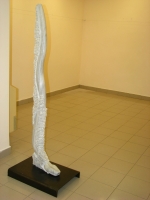According to his tradition of connecting his personal art to early mythical and allegorical stories, Avi Sperber presents a personal version of the story of temptation in the Garden of Eden. His sculptures deal with the dual meanings of the actual participation in the act of temptation that led to man’s first taste of the forbidden fruit of the Tree of Knowledge. The use of boldness, crossing boundaries and stepping out of the borders of what is permitted, is very reminiscent of the work of the creative artist who is sought to confront the forbidden, the other, the abnormal, the extreme and the provocative.
The artistic curator of the Tel Aviv Opera House and “Temptation”, Udi Rosenwein, wrote of Avi Sperber’s exhibition “the installation “Temptation” presents the feelings of indecision and duality in the act of seduction by use of symbols from the biblical story of seduction. The snake, Adam, and Eve, were not satisfied with what they had and desired to take what little they did not possess – in the sense of “stolen water is sweeter”.
Avi Sperber’s sculptures provide a personal and artistic interpretation to the act of seduction. The sculpture of the snake winding itself upwards symbolizes a provocative phallic element that exemplifies the nature of the sin. The scales emphasize the absurdity in the use of the symbolic apple – the innocent fruit, round and sweet, as a fruit forbidden to man, a fruit which eventually took him from a world of total innocence lacking in evil to his present, harsh existence. The scales present the universal dilemma that is found in the danger of crossing boundaries. The sculpture of duality demonstrates the personal preoccupation of the artist and the continuing presence of multiple meanings between his real life and his creative artistic life. The exhibition portrays the ever-present combination found in Avi Sperber’s work of stone and metal. This is especially strong in the series of footprints which commemorate the personal, daring path followed by man – a path lacking in borders and an end, somewhat Sisyphean, relevant and meaningful for each of one of the viewers from within our own world.
Doron Polack, Curator






